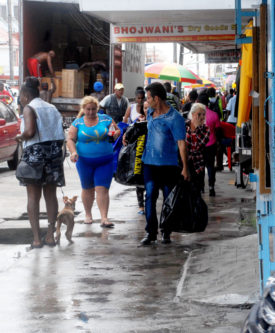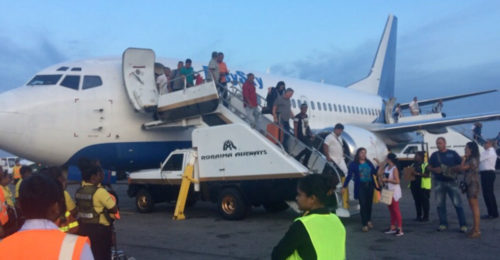On Wednesday, the customary groups of Cubans who now congregate in the city were braving the brisk early morning showers to do so. Compared with those Guyanese who were already out and about and sheltering under the awnings of the Regent Street stores, they appeared unconcerned about the weather, their animated conversations seemingly focused on how to approach the trading day ahead, oblivious to the curious glances that their conversations in rapid Spanish were attracting.
Every day of the week, around 14:00 hrs an Easy Sky 737 jet touches down at the Cheddi Jagan International Airport; approximately 129 Cubans disembark and make their way into Georgetown. Two hours later, the jet departs for Havana with a contingent of Cubans who had arrived here a few days earlier, engaged in brisk business with merchants in the city and were returning home.

These days, one might be forgiven for thinking that Georgetown is a multilingual city. What the Cubans lack in numbers here in the Guyanese capital they make up for in the assertiveness of their dispositions and their ability to utilize their personalities to break the language barrier. Cuba may not be part of that much closer language bond that binds the English-speaking Caribbean Community but there is something in the warmth and breeziness of Cubans that makes them part of the wider Caribbean family. In their efforts to strike up a bond, mostly with the traders on the streets, language is not as formidable a barrier as it otherwise might have been.
The proliferation of Cubans on the streets of Georgetown marks another entirely different chapter in relations between Guyana and Cuba. Formal diplomatic relations were established in 1972 under Forbes Burnham and Fidel Castro. These days, the ideological moorings of the relationship have been outlasted by the more informal ties characterized by the comings and goings of a younger generation of Cubans who have witnessed the gradual economic liberalization of the country even if its politics remains overwhelmingly dominated by a Communist party. The contemporary travellers have cemented a commercial relationship between the two countries that was altogether non-existent four decades ago.

Then, the vast majority of Cubans to be found in Guyana were a handful of diplomats and a somewhat larger numbers of doctors, sent here by their revolutionary government to help shore-up Guyana’s seriously deficient health services. All of that was part of Castro’s early attempt to court the English-speaking Caribbean. In some respects it paid off. Washington’s ceaseless sledging of ‘communist Cuba’ has not, over the years, dimmed what has been the enthusiasm of many Guyanese for the considerable accomplishments of the Cuban revolution. In those days too, our own students took advantage of scholarships provided by the Cuban government to study medicine. These days, some of the most senior medical personnel in Guyana are Cuban-trained and while there are still Cuban doctors working here. The contemporary visitors have a much shorter-term mission.
On Wednesday, the Regent Street stores had opened precisely at the beginning of the trading day. The local merchants know only too well that to allow a contingent of Cuban shoppers to go past your store without stopping is to deny yourself the takings afforded by their bulk buying. The uncertainties of having their trade depending entirely on local patronage has now become an absurd risk which local merchants are far too astute to take.
Roraima Airways Chief Executive Officer Gerry Gouveia whose company brokered the deal with Easy Sky that brings the planeloads of Cubans here every day of the week estimates that each of the visiting Cubans spend around US$3,000 per trip. “That’s a lot of money,” Gouveia says, adding, “What the Cubans spend goes into a number of pockets across the various areas of the business sector.”
The Cubans, he says, represent “a major boost” for trading in the city.
The merchants concur, a few of them showing off the fact that they have upped their game, recruiting Spanish-speaking locals to engage the Cubans who enter their shops. The taxi drivers, too, are welcoming of the Cubans as are the small hotels and bed and breakfast services around the city and even the private homes that offer modest room and board services to the visitors.
On the streets, the Cubans have long blended in. They have graduated from being curious groups of Spanish-speaking foreigners to being part of the urban landscape, their transformation manifested in their easy exchanges with local vendors utilizing a form of communication that combines elaborate gestures with a vocabulary that can only really be understood by the people who utilize it.
The interests of the Cubans who visit, spend a few days, shop then return home, coincide with the interests of a local business community that has grown used to a trading sector that drifts in and out of interludes of sluggishness. Accordingly, the merchants have gone to elaborate lengths to take advantage of the presence of the Cubans. The Spanish-speaking shop attendants apart, some in the city have signs with basic instructions (eg leave bags in bag bay) posted at strategic points in the stores.
Gouveia believes that what is manifesting itself is a new and different phase of a longstanding relationship between Guyana and Cuba. Ironically, he says, the current phase of the relationship has opened up opportunities of for the expansion of the local trading sector. In the case of his own particular company he sees the Easy Sky bridge between Georgetown and Havana as an extension of a wider Roraima Airways business strategy that pursues partnerships with external airlines (the current arrangement which Roraima Airways shares with Dynamic and the planned launch of a similar arrangement with Aruba are good examples of this) to make travel easier between Guyana and North America, particularly.
“The movement of the Cubans between Havana and Georgetown on Easy Sky, like the movement of Guyanese, mostly, between the United States and Guyana by Dynamic are services that have implications that go beyond travel. They are about keeping Guyana connected with the rest of the world, boosting trade, bringing and carrying tourists, allowing Guyanese living in the United States to come and go as they please, whatever the reasons. These days, whenever I see a group of Cubans in the city I cannot help but reflect on the role that Roraima Airways is playing in strengthening ties between Guyana and Cuba in ways that cause of to see the importance of our relationship in a practical way,” he says.




